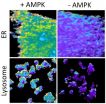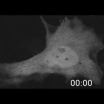(Press-News.org) The enzyme AMPK initiates a dizzying array of cellular activities, from breaking down worn-out cellular parts to turning on energy production. How does a single protein, activated by a single switch, fulfill so many different tasks without getting them mixed up? To get at such a complex question, cell biologists at Johns Hopkins designed several molecular tools that allowed them to watch, measure and manipulate the activity of the enzyme AMPK in individual compartments within the cell. The new tools have confirmed that at least some of AMPK's ability to multitask comes from variations in its activity level in each cellular compartment.
Takanari Inoue, Ph.D., an associate professor of cell biology at the Johns Hopkins University School of Medicine, compares a cell and its compartments to a house with many rooms. "We suspected that the AMPK in some rooms was working harder than in others. We set up spies in each room to monitor its activity. Then we devised a set of saboteurs to shut down AMPK's activity in one room at a time so we could see the effects on the cell," he says.
A summary of the study will appear online in the journal Cell Reports on April 16.
AMPK is a near-ubiquitous enzyme that maintains cells' energy supplies. The main energy currency in cells is a molecule called adenosine triphosphate (ATP) that, as the name suggests, has three phosphate groups attached to it. Energy is released from ATP when one or two of the phosphate groups are removed, leaving adenosine diphosphate (ADP) or adenosine monophosphate (AMP), respectively. If either of those molecules binds to AMPK, the enzyme's shape changes to reveal its activation site, enabling other enzymes to activate it by adding a phosphate group to the site. Once activated, AMPK will add its phosphate group to other proteins, ultimately causing diverse changes in the cell, such as helping it grow in size, break down worn-out cellular parts, develop directionality or turn genes "on." It was unknown how a single protein could produce such varied outcomes, but one hypothesis was that its activity levels were different in different compartments of the cell, allowing it to affect different sets of other proteins.
To see what it was up to, Inoue's team designed a series of special molecules to "spy on" AMPK in specific compartments within lab-grown cells from a variety of species. Once the spies touched AMPK, they emitted light that could be seen and measured. In unstressed cells, the team found varying levels of AMPK activity in different cellular compartments. The nucleus, cytoplasm and cell membrane had the least activity, while the Golgi apparatus and the endoplasmic reticulum had the most.
When the researchers withheld glucose from the cells to lower their energy levels and rev up AMPK activity, they saw that each compartment responded to a different degree and within unique time frames. The greatest change in activity was in the cytoplasm, which saw more than a 40 percent increase in AMPK activity only half an hour after glucose withdrawal that was maintained for four hours. The mitochondria, on the other hand, saw a more modest increase that didn't appear until four hours had passed.
Finally, the team modified the spies so that they could control their location in real time. These spies start off dispersed throughout the cell but then rapidly congregate at a specific compartment in response to a "chemical command" applied to the cells. (see VIDEO) Some of these molecules were simple spies like the others that would report on AMPK's activities, but others were "saboteurs" because they could overwhelm AMPK and distract it from working on what it's supposed to.
"We were able to halt AMPK's activity in specific compartments -- and nowhere else in the cell -- on demand," says Inoue. "And it happens so quickly, within seconds, that it doesn't give the cell's other signaling systems time to adapt, so the observations we make are entirely due to the absence of AMPK activity."
He says the series of molecular tools can be used to further unravel the mystery of AMPK's activities, and those of many other enzymes.
INFORMATION:
Other authors of the report include Takafumi Miyamoto, Elmer Rho, Vedangi Sample, Kirill Gorshkov, Melinda Chen and Jin Zhang of the Johns Hopkins University School of Medicine; Hiroki Akano, Masaki Magari and Hiroshi Tokumitsu of Okayama University in Japan; and Tasuku Ueno of the University of Tokyo.
This work was supported by grants from the National Institute of General Medical Sciences (GM092930); the National Institute of Diabetes and Digestive and Kidney Disorder (DK102910, DK089502); the National Cancer Institute (CA103175); the Ministry of Education, Culture, Sports, Science and Technology of Japan (26440056); the Japan Science and Technology Agency (10216); and the Japanese Society for the Promotion of Science.
Angiogenesis inhibitors--a widely used class of cancer drugs designed to shrink tumors by preventing them from forming new blood vessels--often work in the short term, but usually become ineffective within months. Now, a team led by UC San Francisco scientists has discovered a possible reason, one that could lead to a way to address the problem and prevent cancer relapse.
Working with laboratory models of pancreatic and breast cancer, the scientists found that myeloid cells, which originate in bone marrow and are part of the body's first-line of defense--the so-called ...
How does climate change affect the occurrence and distribution of species? This is a key question in the climate debate, and one that is hard to answer without information about natural variation in species abundance. Now researchers from Uppsala University can, for the first time, give us a detailed picture of natural variation through a major study published today in the leading scientific journal Current Biology.
The impact of climate change on species occurrence and distribution is a central issue in the climate debate, since human influence on the climate risks posing ...
The nutrients excreted by fish in their "pee" may be critical to the health of coastal ecosystems. But knowing whether generalizations can be made about how to predict these nutrient levels in various ecosystems has vexed researchers - until now.
In a paper published in Proceedings of the National Academy of Sciences, North Carolina State University associate professor Craig Layman and colleagues show that ecologists can better predict the rates of how these chemical nutrients are transferred by fish if they know the various fish species living in an ecosystem, along ...
An international team of scientists, led by researchers at University of California, San Diego School of Medicine, have found genetic overlap between Alzheimer's disease (AD) and two significant cardiovascular disease risk factors: high levels of inflammatory C-reactive protein (CRP) and plasma lipids or fats. The findings, based upon genome-wide association studies involving hundreds of thousands of individuals, suggest the two cardiovascular phenotypes play a role in AD risk - and perhaps offer a new avenue for potentially delaying disease progression.
The findings ...
A potentially game-changing breakthrough in artificial photosynthesis has been achieved with the development of a system that can capture carbon dioxide emissions before they are vented into the atmosphere and then, powered by solar energy, convert that carbon dioxide into valuable chemical products, including biodegradable plastics, pharmaceutical drugs and even liquid fuels.
Scientists with the U.S. Department of Energy (DOE)'s Lawrence Berkeley National Laboratory (Berkeley Lab) and the University of California (UC) Berkeley have created a hybrid system of semiconducting ...
CORVALLIS, Ore. - A national survey suggests that slightly more than half of the older adults in the United States are now taking a daily dose of aspirin, even though its use is not recommended by the Food and Drug Administration for most people who have not yet had a heart attack or stroke.
The analysis was published today in the American Journal of Preventive Medicine. It observed that aspirin use is continuing to surge, especially among adults who are using it for "primary prevention," meaning in order to prevent an initial cardiovascular event, and in some cases to ...
The psychological impact and private agony of infertility must be carefully considered by healthcare professionals, suggests a new review, published today (Friday 10 April) in The Obstetrician & Gynaecologist (TOG). The review identifies infertility as a complex state and life crisis and sets out the dangers of neglecting the emotional impact of involuntary childlessness and viewing it solely in biological or medical terms.1
The article provides an introduction to infertility counselling in the UK, within the context of fertility treatment. This includes an explanation ...
Analysis of the longer-term influence of menopausal hormone therapy on breast cancer incidence in two Women's Health Initiative (WHI) clinical trials suggests a pattern of changing influences over time on breast cancer, according to an article published online by JAMA Oncology.
Use of menopausal hormone therapy decreased dramatically after reports of increased breast cancer risk with estrogen plus progestin from the WHI randomized clinical trial followed by the Million Women Study observational analysis. Following the initial WHI reports, decreases in both combined estrogen ...
Obesity was associated with an increased risk for prostate cancer in African American men and that risk grew by nearly four times as body-mass index (BMI) increased, according to an article published online by JAMA Oncology.
African American men have the highest incidence of prostate cancer of any racial or ethnic group in the United States, as well as the highest rates of aggressive disease and prostate cancer death. These elevated risks likely arise from both social and biologic factors. The associations of obesity with prostate cancer risk are complex.
Wendy E. Barrington, ...
Advice on preventing and treating venous thromboembolism (VTE) during pregnancy, birth and following delivery is outlined in two new revised guidelines published today (13 April) by the Royal College of Obstetricians and Gynaecologists (RCOG) and launched at the RCOG World Congress in Brisbane, Australia.
VTE refers to the formation of a clot within veins. This can occur anywhere in the venous system, but the predominant sites are in the vessels of the leg (giving rise to deep vein thrombosis (DVT)) and in the lungs (resulting in a pulmonary embolism (PE)).
The Green-top ...



